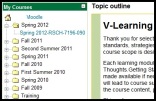Online Learning Part 4 – Types and Extent of Online Learning
by Mark Sivy
Online learning exists in different forms and they vary based upon the intended outcomes, level of interactivity, number or users, and the forms of communication which are used. Four general types are:
- Static Information (usually low level of interactivity, single user, reading)
This can provide intentional learning as in the case of online frequently-asked-questions or other knowledge bases which were purposefully created to provide some form of education for targeted learners. This information could be for a specific subject, process, task, or product. Other online information such as blogs, wikis, and websites can provide unintentional learning in the sense that they are not provided for a specific audience, but rather have been posted for public access and can be found through searches or “web-surfing”. These usually require low levels of interactivity and engagement other than reading.
- Web-based Support (usually moderate level of interactivity, multiple users, text-based communication exchanges)
Learning occurs through the use of forums, chat rooms, discussion boards, text-messaging, e-mail, or live instant-messaging. This form of learning often involves a knowledgeable person who responds to learning by answering specific questions or providing needed information.
- Synchronous (usually moderate to high level of interactivity, multiple users, various forms of sensory input)
This occurs in real-time with a live instructor presenting information or with a facilitator guiding learning activities and processes. It can be similar to a traditional class meeting, but the meeting is via the Internet using a specialized meeting technology rather than within a physical space. Everyone logs into the common application or system at a specified time and for a given length of time. An event can happen once or meetings can occur on a regular basis for as many times as is required. Communication typically involves text, voice, and sometime video.
- Asynchronous (usually moderate to high level of interactivity, single to multiple users, various forms of sensory input)
This is the most commonly used category for web-based learning which is occurring in association with a given course or class. It involves self-paced learning which means the learner accesses learning materials, resources, activities, etc. at a time which fits their schedule and location. The usual pacing limits or guidelines are based upon course syllabi and daily, weekly, or term-based timelines. Often asynchronous learning happens through a well-designed website or learning management system which has been developed by an instructor or team of instructors. Even though learning can this type of learning can occur individually, it usually involves a combination of individual and group efforts.
For more on synchronous and asynchronous online learning, read EDUCAUSE and eLearners.com articles.
Reflection Point 1 – I hear and I forget, I see and I remember, I do and I understand. ~ Confucius
Extent of Online Learning
Online learning can also be described based upon the degree to which the learning occurs online:
 Fully online – the instruction and learning occurs almost completely in the online environment.
Fully online – the instruction and learning occurs almost completely in the online environment.- Hybrid / Blended – there is a blend between substantial learning occurring both online and face-to-face.
- Supplemental – the majority of learning occurs in the physical classroom with ancillary materials and resources available online.
Reflection Point 2 – Good teaching is good teaching, no matter how it’s done. ~ Anonymous




